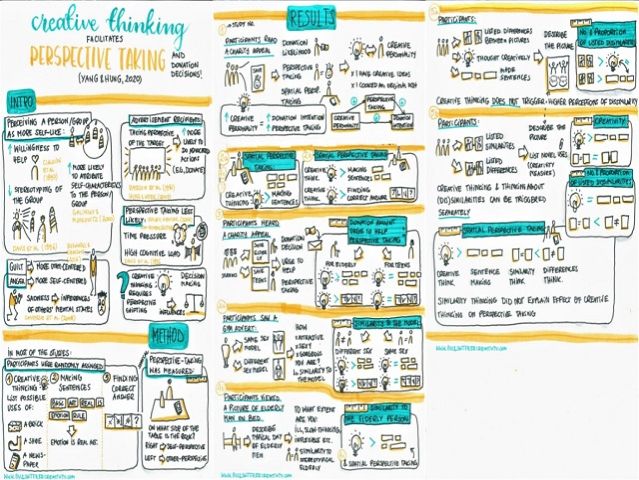How to accelerate social change? Creative thinking boosts donations and triggers perspective taking
| Datum: | 02 februari 2021 |
| Auteur: | Marta Wronska |

In a world of rapid growth and innovations, numerous problems are still waiting to be solved. Fortunately, nonprofits keep inventing and implementing incredible solutions. But even the most effective charities are limited by funding. Yet, it turns out that this problem can be also addressed through… creative thinking. Engaging in creativity triggers perspective taking and boosts donations, according to a recent article published in the Journal of Personality and Social Psychology.
Source: Author Click here for the larger version of the visual summary
Over the centuries, creativity has made the world a better place. It prolonged our lives, and it increased our safety and prosperity. Thanks to creativity and innovation, we don’t need to worry about food or shelter. Instead, we can focus on business, science, and art. Many of us can – but that’s not true universally. There are some who lack food and shelter, who die from curable diseases, and who spend their lives in pain and distress. One billion people live in extreme poverty, without access to clean water, dying from hunger, malaria, and parasitic worms. Every year, 50 billion non-human animals experience chronic suffering in factory farms.
So what can we do to address these pressing problems? The answer is simple: donate. Open Philanthropy Project estimates that 1 dollar prevents 250 hens from being confined in a cage for a year, while according to Give Well, it costs less than 10 dollars to purchase and install a bed net that saves lives from malaria. While the Effective Altruism movement encourages people to donate, it’s still a rare behavior. And this is not surprising. Some people lack knowledge about effective charities and important causes. Others are occupied with everyday worries and unable to look from the perspective of the victims, far away from the here and now. So how can we encourage people to do more good?
Zheshuai Yang from Zhejiang University and Iris W. Hung from Fudan University offered an innovative solution. Rather than using creative thinking to solve global problems, they proposed that creativity can trigger perspective taking, and thus, encourage donations. To generate many different ideas, we need to think flexibly and shift our typical perspective. In this flexible state, it should be easier to look from the perspective of a victim. And from there, the chances for donating should get higher.
In their experiments, Yang and Hung asked half of the students to solve a creative task, so to list possible uses of a brick, a shoe, and a newspaper. The other half made sentences from sets of words, which served as a control task. Then, all participants completed a spatial perspective taking task. They saw a photograph of a person sitting at a table, on which a book and a bottle were placed. Participants indicated on which side of the table the book was. If they adopted the perspective of the photographed person, they took an other-perspective, but if they saw the book from their side, this indicated a self-perspective.
In some of the studies, the researchers also measured donation amount in a compelling way. After completing the creative or the control task, participants were approached by the experimenter, ostensibly a volunteer from a real charity. Half of the participants were told that the elderly – people different from them – needed help. The other half was asked to help the adolescents, a group similar to them. Participants could put their donations in an envelope. Finally, they indicated their urge to help the elderly or the adolescents and rated to what extent they took the perspective of the beneficiaries.
The results were unambiguous: in four studies, those who completed a creative task looked from the other-perspective more often than those who worked on sentences. Additionally, those with a creative state of mind made a higher donation, felt a higher urge to help, and took the perspective of the beneficiaries to a higher extent than those who made sentences. Importantly though, this depended on the type of beneficiaries. Creative thinking encouraged helping and perspective-taking when the donation concerned the elderly – people different from the student participants – but not when students were asked to support the adolescents, who were similar to them.
The activated perspective-shifting mindset influences the message impact only when the demand for a shift in perspectives is apparent, the authors pointed out. But in fact, this shift is necessary for most of the pressing problems. Imagining life in extreme poverty or in factory farms requires a considerable change in perspective, and creative thinking can be particularly helpful in enabling such switches. As a result, creative thinkers might donate more money that will save lives and decrease the suffering of both human and non-human animals.
How can you use creativity to shift perspectives and increase donations? Here are some ideas related to this research:
- If possible, approach potential donors just after they had been involved in creative thinking
- Present the cause from an unusual, surprising perspective to evoke perspective switching
- Engage your audience in idea generation before requesting the donation
Marta Wronska (m.k.wronska@rug.nl) is a PhD candidate at the Department of Human Resource Management & Organizational Behavior, University of Groningen. Her dissertation is about motivational mechanisms involved in creativity, such as how engaging in creativity influences attentional breadth (broad or narrow lens through which people perceive the world) and how active goals influence creative problem solving through cognitive mechanisms. She creates a knowledge base for effective animal advocates about creative thinking at www.bullshitfreecreativity.com.
References
Yang, Z., & Hung, I. W. (2020). Creative thinking facilitates perspective taking. Journal of Personality and Social Psychology. https://doi.org/10.1037/pspa0000259


